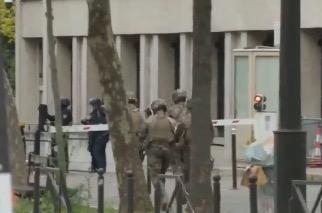Media
When Does Flagging False Content on Social Media Backfire? – Slate

Tim Mossholder/Unsplash
In the past few months, social media companies have scrambled to address the misinformation tearing through their platforms—first about the election, then the coronavirus. Twitter has started using manipulated media labels. Facebook has been more aggressively removing harmful content and flagging false news. This week, YouTube announced that it will add information panels to searches in the U.S. that might bring up misinformation.
At the heart of these measures is fact checking. At Facebook, the “epicenter of misinformation,” an expanding network of professional fact checkers is sifting through the site’s posts to slap warning labels on false content. At first glance, these efforts appear uniformly good. But what’s the psychology behind those flags? How effective are they? And do red flags ever embolden the very users they’re meant to deter?
A study published this month by researchers at New York University’s Tandon School of Engineering and the University of Indiana sought to answer these questions. The researchers found that credibility indicators, or flags, can reduce users’ intentions to share fake content on social media regardless of political orientation. In short, fact-checking sources are overwhelmingly trusted. Yet the more nuanced conclusion is that the effect of these flags varies significantly based on gender and political orientation: Men are more 1.5 times more likely to share news that’s been flagged as false, the study concluded, while Republicans are much more inclined to disseminate that news than Democrats or independents.
The findings were based on an online study with 1,500 participants in the U.S. These participants saw 12 true, false, and satirical headlines marked with one of four types of credibility indicators: warnings that came from fact checkers, news media, the public, or artificial intelligence. Then, they were asked if they would share the article with friends. (The indicators from fact checkers and A.I. are the most relevant to current social media policies. Facebook, for instance, has used A.I. to spot hoaxes copied and pasted by different accounts.)

An example of a “credibility indicator” by fact checkers in the study.
Proceedings of the 2020 ACM CHI Conference on Human Factors in Computing Systems
The most effective indicator by far was fact checkers. Participants intended to share 43 percent fewer headlines that were marked untrue by fact checkers: 61 percent fewer for Democrats, compared with 40 percent for independents and 19 percent for Republicans. As for A.I., Democrats intended to share 40 percent fewer untrue headlines with the A.I. indicator, versus 16 percent for independents. Notably, Republicans said they would share 8 percent more untrue news with the AI indicator. “We were not expecting that, although conservatives may tend to trust more traditional means of flagging the veracity of news,” said Sameer Patil, a co-author of the study, in a press release.
Admittedly, this is just one study, but it’s important for two reasons. First, it provides further evidence that the “backfire effect,” or the idea that fact-based corrections may actually reinforce false beliefs, isn’t as serious as some researchers have believed. Over the past decade, understanding around the effects of flagging misinformation has shifted away from the backfire effect, which was popularized by a 2010 study. But the concerns over the effect has lingered. Facebook itself noted that “[a]cademic research on correcting misinformation has shown that putting a strong image, like a red flag, next to an article may actually entrench deeply held beliefs,” when it temporarily ditched the disputed flag in 2017. The general findings of the new study align with a 2019 study by Paul Mena, a lecturer at the University of California, Santa Barbara, who also concluded that warning labels may indeed disincentivize Facebook users from sharing fake news.
Second, the new research also provides insight into how partisanship and demographics affect misinformation campaigns—an area that’s so far been understudied. However, its conclusions should be taken with a grain of salt. The paper itself acknowledged the limitations of generalizing from this research, especially since even though they “carefully worded the indicators in a politically neutral way … [they] cannot rule out the influence of inherent systemic political biases regarding technology or the media.”
That said, this research aligns with a 2019 study that also found that during the 2016 presidential election campaign, 18 percent of Republicans shared links to fake news sites, compared to less than 4 percent of Democrats. Yet the 2019 study similarly cautioned against associating ideology with a predisposition to share false content, since most fake news circling during the campaign was pro-Trump or anti-Clinton. In Mena’s study, which did not focus on political affiliation and controlled for political leaning, Democrats were actually more likely to share false news with or without a warning label—though Republicans’ behavior was less affected by these labels. But Mena told me that this outcome likely resulted from the headlines he used being more ideologically attractive to Democrats, since the majority of his participants were Democrats. “More research is needed,” he said. “A possible explanation would be that the observed effect of political affiliation depends on the topic of the false news story.”
Regardless of the effects of partisanship, the new study’s findings are positive. In his 2019 study, Mena confirmed evidence of the “third-person effect,” where people believe that others are more likely to share false news—with or without flags—than themselves; essentially, we tend to overestimate the effects of misinformation on others. Ultimately, the new study only further shows that while people generally tend to have negative opinions of others’ gullibility or intentions, a much smaller percentage of people will share hoaxes when they’re flagged. Which is to say that Facebook and other social media sites should continue to moderate and mark their content, especially when large swaths of misinformation amid the current infodemic go undetected (and even look potentially more trustworthy without a label). As Patil pointed out, making fact checkers efficient enough to tackle the current scale of falsities floating around might require greater use of artificial intelligence moderators. “This could include applying fact checks to only the most-needed content, which might involve applying natural language algorithms. So, it is a question, broadly speaking, of how humans and AI could co-exist,” he said.
Future Tense
is a partnership of
Slate,
New America, and
Arizona State University
that examines emerging technologies, public policy, and society.
Media
Lawmakers pan Ben Gvir for ‘unforgivable’ tweet on alleged Israeli strike on Iran – The Times of Israel


Italian FM says Israel gave US ‘last minute’ warning about drone attack on Iran
CAPRI, Italy (AP) — The United States told the Group of Seven foreign ministers that it received “last minute” information from Israel about a drone action in Iran early this morning, Italy’s foreign minister says.
Italian Foreign Minister Antonio Tajani, who chaired the meeting of ministers of industrialized countries, says the United States provided the information at session this morning that was changed at the last minute to address the suspected attack.
Tajani says the US informed the G7 ministers that it had been “informed at the last minute” by Israel about the drones. “But there was no sharing of the attack by the US. It was a mere information.”
Early Friday, Iran fired air defenses at a major air base and a nuclear site near the central city of Isfahan after spotting drones, part of an apparent Israeli attack in retaliation for Tehran’s unprecedented drone-and-missile assault on the country last weekend.
In a communique following the three-day meeting, the ministers urged the parties “to prevent further escalation.”
Media
DJT Stock Rises. Trump Media CEO Alleges Potential Market Manipulation. – Barron's
[unable to retrieve full-text content]
DJT Stock Rises. Trump Media CEO Alleges Potential Market Manipulation. Barron’s





Source link
Media
DJT Stock Rises. Trump Media CEO Alleges Potential Market Manipulation. – Barron's
[unable to retrieve full-text content]
DJT Stock Rises. Trump Media CEO Alleges Potential Market Manipulation. Barron’s





Source link
-
Media9 hours ago
DJT Stock Rises. Trump Media CEO Alleges Potential Market Manipulation. – Barron's
-
Media11 hours ago
Trump Media alerts Nasdaq to potential market manipulation from 'naked' short selling of DJT stock – CNBC
-
Investment10 hours ago
Private equity gears up for potential National Football League investments – Financial Times
-
Media24 hours ago
DJT Stock Jumps. The Truth Social Owner Is Showing Stockholders How to Block Short Sellers. – Barron's
-



 Health24 hours ago
Health24 hours agoType 2 diabetes is not one-size-fits-all: Subtypes affect complications and treatment options – The Conversation
-
Business24 hours ago
Tofino, Pemberton among communities opting in to B.C.'s new short-term rental restrictions – Vancouver Sun
-
Business23 hours ago
A sunken boat dream has left a bad taste in this Tim Hortons customer's mouth – CBC.ca
-
News22 hours ago
Best in Canada: Jets Beat Canucks to Finish Season as Top Canadian Club – The Hockey News









